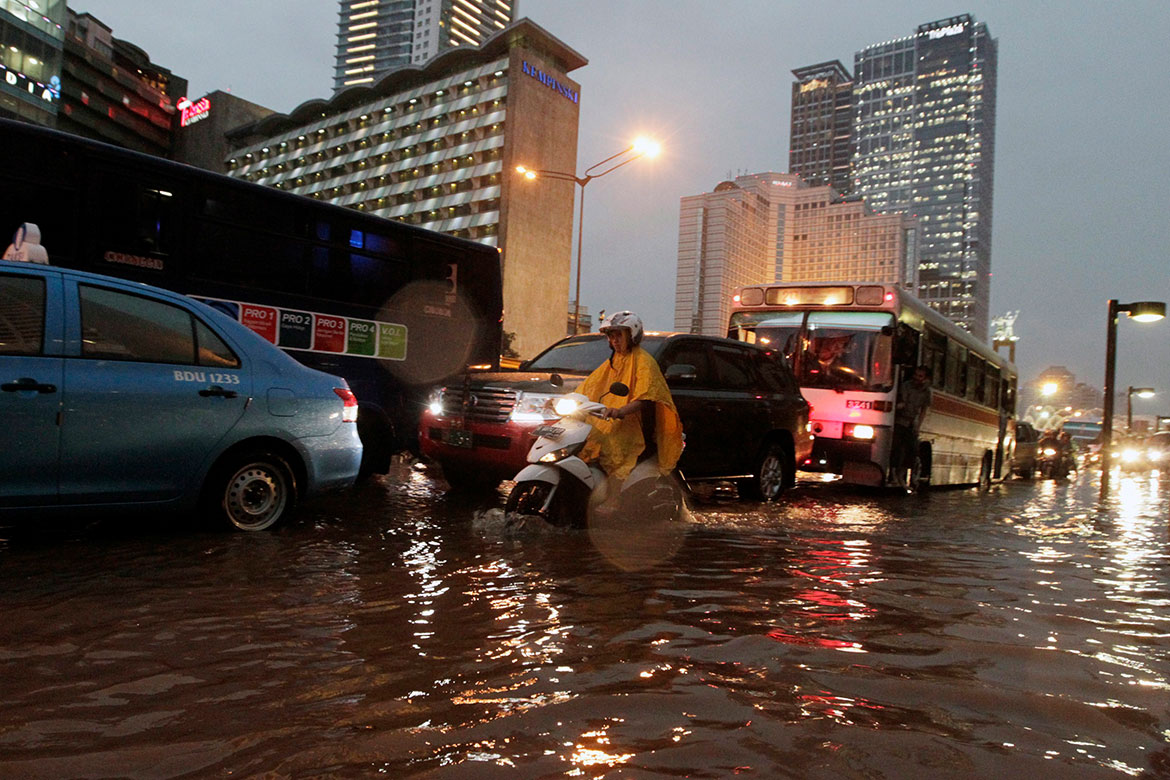Feature: Better cities
Preventing the next Atlantis
Many coastal cities with millions of inhabitants are slowly sinking, and the sea level just keeps rising. We take a look at researchers’ plans to use water itself to prevent Jakarta from becoming the next Atlantis

Forty percent of the Indonesian capital Jakarta lies below sea level. As a result, this megacity is repeatedly plagued by flooding. | Image: Mast Irham/EPA/Keystone
In 2019 Singapore’s prime minister, Lee Hsien Loong, announced that the city-state will have to invest at least USD 100 billion in coastal protection over the next 50–100 years if it is to survive. That same year, the Indonesian President Joko Widodo announced plans to relocate the capital city of Jakarta, which has sunk two metres in the past century and is increasingly plagued by floods. Its new site is to be in the province of East Kalimantan on the island of Borneo. Singapore and Jakarta are not isolated cases: 62 percent of cities with more than eight million inhabitants are situated near the sea. In Southeast Asia alone, over 400 million people live in low-lying coastal areas.
They are all threatened by rising sea levels, coastal erosion, increasingly frequent typhoons, the destruction of coastal ecosystems and the salinisation of soil and groundwater. Global warming is causing the oceans to expand, while also accelerating the melting of ice that was previously on land. According to calculations made by the Intergovernmental Panel on Climate Change (IPCC), sea levels have risen by a global average of 20 cm over the past 100 years. According to different climate scenarios, the sea level is due to rise by 50 to 100 cm by the year 2100 – though there will be major regional differences.
Using water to store greenhouse gases
“We can no longer halt the rising seas”, says Oscar Carracedo, a professor of urban design at the National University of Singapore. “There are three possibilities open to coastal cities that want to adapt: building protective walls, raising the cities, or moving them further from the coast”. Carracedo is the lead researcher in the project ‘The Sea-City Interface’ at the Future Cities Lab of ETH Zurich. For a year now, his team has been researching into strategies to help Asian coastal cities adapt to the increasing challenges facing them.
“The possibilities for adapting are largely known and they’re limited”, says Carracedo. But his team wants to go one step further and combine adaptation with mitigation. “We are researching into cities that can give something back to the environment”. He is speaking of regenerative design, which can help a city to maintain resources in circulation and renew them. In future, cities should not only be producing fewer emissions, but could even absorb greenhouse gases from the air. To achieve this, Carracedo and his team do not want to rely solely on nature-based solutions such as reforestation. They are also investigating technologies for CO2 capture. “High-rise buildings could one day become artificial trees, absorbing CO2 from the air”, he says. This will require new materials that can be integrated into building façades. For this reason, the Sea-City Interface project is also working with engineers, physicists, chemists and biologists from Singapore and Zurich.
Their focus on coastal cities lends itself to this kind of research, explains Carracedo, because these regenerative processes need a lot of water, as does storing greenhouse gases. However, they are also going to be testing new possibilities for the storage and use of rainwater. These ideas are still rather utopian at the moment, he admits, but he remains convinced that they are the way forward: “In view of the enormous urban challenges facing us, we have to start thinking in utopian terms; we need to be disruptive”. He is aware that visions like this offer little hope for the millions of people living in informal settlements in Southeast Asian megacities like Jakarta, whose makeshift homes are already being washed away by rising seawaters. “The poorest have only one priority: to adapt as quickly as possible”. That once more means building protective walls, raising the height of cities, or moving them away from the coastline.




